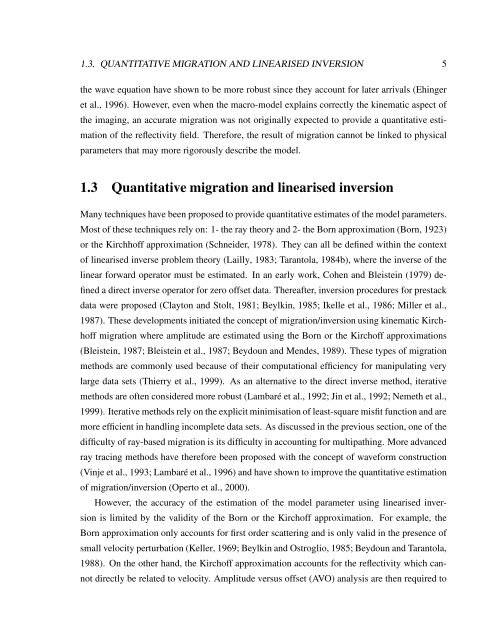Sirgue, Laurent, 2003. Inversion de la forme d'onde dans le ...
Sirgue, Laurent, 2003. Inversion de la forme d'onde dans le ...
Sirgue, Laurent, 2003. Inversion de la forme d'onde dans le ...
You also want an ePaper? Increase the reach of your titles
YUMPU automatically turns print PDFs into web optimized ePapers that Google loves.
1.3. QUANTITATIVE MIGRATION AND LINEARISED INVERSION 5<br />
the wave equation have shown to be more robust since they account for <strong>la</strong>ter arrivals (Ehinger<br />
et al., 1996). However, even when the macro-mo<strong>de</strong>l exp<strong>la</strong>ins correctly the kinematic aspect of<br />
the imaging, an accurate migration was not originally expected to provi<strong>de</strong> a quantitative estimation<br />
of the ref<strong>le</strong>ctivity field. Therefore, the result of migration cannot be linked to physical<br />
parameters that may more rigorously <strong>de</strong>scribe the mo<strong>de</strong>l.<br />
1.3 Quantitative migration and linearised inversion<br />
Many techniques have been proposed to provi<strong>de</strong> quantitative estimates of the mo<strong>de</strong>l parameters.<br />
Most of these techniques rely on: 1- the ray theory and 2- the Born approximation (Born, 1923)<br />
or the Kirchhoff approximation (Schnei<strong>de</strong>r, 1978). They can all be <strong>de</strong>fined within the context<br />
of linearised inverse prob<strong>le</strong>m theory (Lailly, 1983; Taranto<strong>la</strong>, 1984b), where the inverse of the<br />
linear forward operator must be estimated. In an early work, Cohen and B<strong>le</strong>istein (1979) <strong>de</strong>fined<br />
a direct inverse operator for zero offset data. Thereafter, inversion procedures for prestack<br />
data were proposed (C<strong>la</strong>yton and Stolt, 1981; Beylkin, 1985; Ikel<strong>le</strong> et al., 1986; Mil<strong>le</strong>r et al.,<br />
1987). These <strong>de</strong>velopments initiated the concept of migration/inversion using kinematic Kirchhoff<br />
migration where amplitu<strong>de</strong> are estimated using the Born or the Kirchoff approximations<br />
(B<strong>le</strong>istein, 1987; B<strong>le</strong>istein et al., 1987; Beydoun and Men<strong>de</strong>s, 1989). These types of migration<br />
methods are commonly used because of their computational efficiency for manipu<strong>la</strong>ting very<br />
<strong>la</strong>rge data sets (Thierry et al., 1999). As an alternative to the direct inverse method, iterative<br />
methods are often consi<strong>de</strong>red more robust (Lambaré et al., 1992; Jin et al., 1992; Nemeth et al.,<br />
1999). Iterative methods rely on the explicit minimisation of <strong>le</strong>ast-square misfit function and are<br />
more efficient in handling incomp<strong>le</strong>te data sets. As discussed in the previous section, one of the<br />
difficulty of ray-based migration is its difficulty in accounting for multipathing. More advanced<br />
ray tracing methods have therefore been proposed with the concept of waveform construction<br />
(Vinje et al., 1993; Lambaré et al., 1996) and have shown to improve the quantitative estimation<br />
of migration/inversion (Operto et al., 2000).<br />
However, the accuracy of the estimation of the mo<strong>de</strong>l parameter using linearised inversion<br />
is limited by the validity of the Born or the Kirchoff approximation. For examp<strong>le</strong>, the<br />
Born approximation only accounts for first or<strong>de</strong>r scattering and is only valid in the presence of<br />
small velocity perturbation (Kel<strong>le</strong>r, 1969; Beylkin and Ostroglio, 1985; Beydoun and Taranto<strong>la</strong>,<br />
1988). On the other hand, the Kirchoff approximation accounts for the ref<strong>le</strong>ctivity which cannot<br />
directly be re<strong>la</strong>ted to velocity. Amplitu<strong>de</strong> versus offset (AVO) analysis are then required to

















